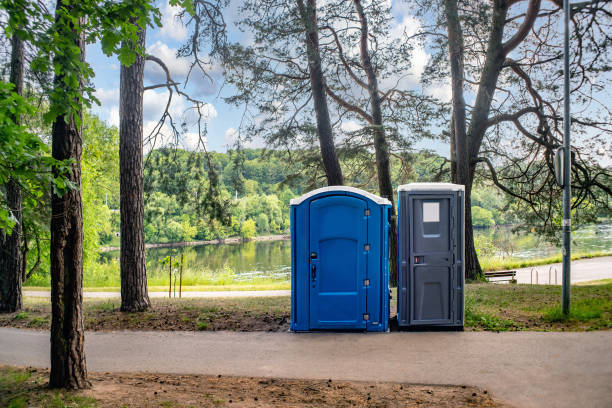Have you ever wondered why we sometimes refer to bathrooms as “the John”?
While it might seem like just another quirky part of the English language, the term actually has a fascinating historical origin. Understanding this can add a layer of intrigue to something as mundane as a trip to the bathroom.
Today, we at ADV Porta Potty Rental, your trusted partner in providing superior portable sanitation solutions, will take you on a journey through time to uncover the origins of this peculiar term.
Who is John Harington?
To understand why bathrooms are called “John,” we need to start with John Harington. Born in the 16th century, John Harington was an English courtier, writer, and, most notably, an inventor.
His contribution to bathroom history is significant, as he is often credited with inventing the first flush toilet. Interestingly, his name is sometimes spelled John Harrington, which can lead to some confusion in historical texts.
John Harington was not just any inventor; he was a godson of Queen Elizabeth I, which played a crucial role in his life and work. He was a man of many talents, dabbling in poetry and serving at the court of the queen. However, his most lasting legacy comes from his work on sanitation.
The Invention of the Flush Toilet
The story of the flush toilet begins in the late 16th century. At that time, sanitation was a significant issue in England, with most people using chamber pots or rudimentary pit latrines. The lack of proper sanitation facilities often led to the spread of diseases, making the need for a better solution all the more pressing.
John Harington devised a revolutionary invention he called the water closet. This early version of the modern toilet could flush away waste using water, which was a groundbreaking idea at the time. His invention consisted of a cistern that would release water to flush the waste into a pit below. While this might seem basic by today’s standards, it was a monumental step forward in sanitation.
In 1596, John Harington installed a prototype of his water closet at his estate. He also installed one for his godmother, Queen Elizabeth I, at her palace in Richmond. The queen’s approval was a significant endorsement of his invention, although it didn’t gain widespread adoption immediately.
Influence of Queen Elizabeth I
The influence of Queen Elizabeth I on John Harington’s work cannot be overstated. As his godmother, she had a vested interest in his success and well-being. Her endorsement of his flush toilet gave it a certain level of prestige and legitimacy. While the invention was considered somewhat of a novelty at the time, her support helped it gain recognition.
It’s worth noting that Queen Elizabeth I was known for her progressive views on many issues, including health and sanitation. Her willingness to adopt John Harington’s invention speaks to her forward-thinking nature and her desire to improve living conditions, even within the royal court.
However, despite the royal endorsement, the water closet did not become widely popular during John Harington’s lifetime. It would take several more centuries and numerous improvements before the concept of the flush toilet became a common fixture in households around the world.
The Term “John” and Its American Roots
So how did the term “John” come to be associated with bathrooms, particularly in the United States? The answer lies in the quirks of American English and the influence of early settlers. The term “John” became a popular slang term for a toilet in America, likely due to the lasting impression of John Harington’s invention. While the exact origins of this specific usage are murky, it’s clear that John Harington’s contribution to sanitation left a significant mark on history.
As settlers moved to America and brought with them various aspects of their culture and language, the term “John” began to be used more widely. By the 19th century, it had become a common slang term for a bathroom in the United States. This linguistic shift underscores the unique path of American English, which often adopts and adapts terms in ways that differ from British English.
Evolution of Bathroom Facilities
17th Century
In the 17th century, after John Harington’s invention, sanitation was still a significant issue. While the water closet was a remarkable innovation, it didn’t immediately catch on. Most people continued to use chamber pots and basic latrines. However, the concept of a flushing toilet slowly began to take root, thanks in part to Harington’s design.
18th Century
Moving into the 18th century, there were gradual improvements in sanitation and plumbing. Innovations such as more reliable water supply systems and better waste disposal methods started to emerge. However, it wasn’t until the 19th century that significant strides were made in bathroom facilities.
19th Century
The 19th century saw a revolution in plumbing and sanitation. Advances in technology and engineering made it possible to develop more sophisticated plumbing systems. This period marked the beginning of the modern bathroom as we know it. The flush toilet became more common, thanks to improvements in design and functionality. The introduction of the S-trap by Alexander Cummings in 1775, which prevents sewer gases from entering buildings, was a crucial innovation.By the late 19th century, flush toilets were becoming a standard fixture in many homes, particularly in urban areas. The term “water closet” remained in use, but “John” also became a popular slang term, especially in American English.
Interesting Facts and Myths
John Harington’s 102 God-Children
One of the more intriguing aspects of John Harington’s life is that he had 102 god-children. This fact, while seemingly unrelated to his invention, adds a layer of richness to his historical persona. It suggests that he was a well-connected and perhaps well-liked figure in his time.
Stale Subject?
Some might consider the topic of toilets a stale subject, but the history of sanitation is anything but dull. The development of the flush toilet and the evolution of bathroom facilities have had profound impacts on public health and daily life. The humble toilet is a marvel of engineering and a testament to human ingenuity.
Portable Toilet Industry
Fast forward to today, the portable toilet industry has taken the principles of John Harington’s invention and adapted them for modern needs. Portable toilets are essential for a wide range of events, construction sites, and emergencies, providing convenient and hygienic solutions where traditional restrooms are unavailable.
At ADV Porta Potty Rental, we pride ourselves on offering clean, comfortable, and convenient portable restroom facilities for every occasion. Our extensive inventory of modern porta-potties is designed to meet the unique needs of our clients, ensuring the highest standards of hygiene and convenience.
Environmental Considerations
In modern times, environmental considerations are crucial. Traditional toilets can use a significant amount of water per day. For example, a standard flush toilet can use up to 1.6 gallons of water per flush. In contrast, portable toilets are designed to minimize water usage, making them an environmentally friendly option for temporary sanitation needs.
Modern Implications and the Portable Toilet Industry
As we move into modern times, the implications of John Harington’s invention of the flush toilet are more apparent than ever. The principles he introduced have been adapted and refined, leading to the advanced sanitation systems we rely on today. The evolution from the early water closet to the high-efficiency toilets we use now highlights the ongoing importance of innovation in this field.
Portable toilets have become an essential aspect of modern sanitation, particularly in settings where traditional plumbing is unavailable. Events, construction sites, and disaster relief efforts all depend on the convenience and hygiene provided by portable toilets. At ADV Porta Potty Rental, we are dedicated to maintaining the highest standards in the portable toilet industry, ensuring that our units are clean, comfortable, and convenient for all users.
Environmental Considerations
One of the key benefits of portable toilets is their environmental impact. Traditional flush toilets can use a significant amount of water per day, which is a concern in areas where water conservation is important. For instance, a standard toilet can use up to 1.6 gallons of water per flush, adding up to a substantial amount over time. Portable toilets are designed to use minimal water, often relying on chemical treatments to manage waste and reduce the need for frequent flushing.
The Enduring Legacy of John Harington
The legacy of John Harington extends far beyond the invention of the flush toilet. His work laid the groundwork for modern sanitation practices, improving public health and quality of life for countless people. His name lives on in the colloquial use of “John” to refer to bathrooms, particularly in American English.
Addressing Common Misconceptions
There are several common misconceptions about John Harington and his contributions. One such myth is that his invention was immediately popular and widely adopted. In reality, it took several centuries for the flush toilet to become a standard fixture in homes and public spaces. Harington’s design was a critical first step, but it required further innovations and improvements to reach its full potential.
The Role of ADV Porta Potty Rental
At ADV Porta Potty Rental, we honor the legacy of John Harington by continuing to innovate in the field of portable sanitation. Our mission is to provide superior portable restroom facilities that are clean, comfortable, and convenient. Whether for large-scale events, construction sites, or emergency situations, our extensive inventory of modern porta-potties is designed to meet the unique needs of our clients.
We understand that high standards of hygiene are crucial, and we strive to ensure that our units are always maintained to the highest levels of cleanliness. Our commitment to excellence ensures a seamless experience for all users, reflecting the pioneering spirit of John Harington.
Conclusion
The journey from John Harington’s 16th century invention of the flush toilet to the modern portable toilet industry is a testament to human ingenuity and the ongoing quest for better sanitation solutions. While the term “John” might seem like a quirky part of the English language, it represents a rich history of innovation and progress.
At ADV Porta Potty Rental, we are proud to be a part of this legacy, providing top-quality portable sanitation solutions that make a difference in people’s lives. Whether you’re planning a large event, managing a construction project, or responding to an emergency, our portable restrooms are designed to deliver the highest standards of hygiene and convenience.



